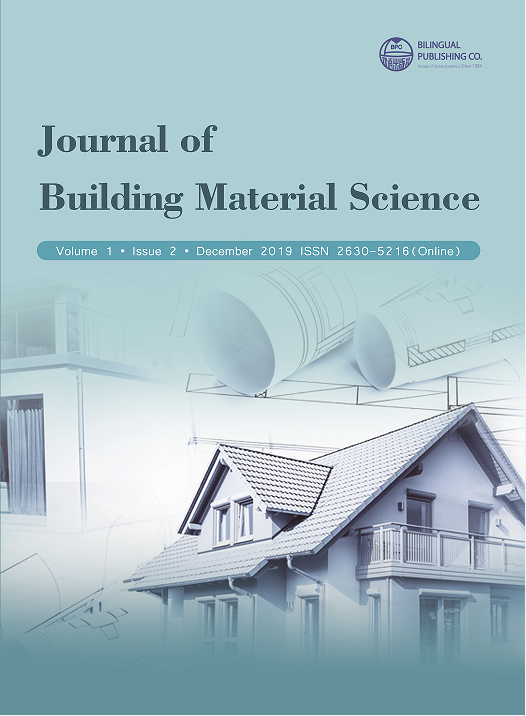
Cementitious Composites Containing Multifunctional Sugarcane Fibres
DOI:
https://doi.org/10.30564/jbms.v1i2.1216Abstract
This work investigates the reuse of natural (SCB) and aminopropyltriethoxysilane-modified (MSCB) sugarcane bagasse fibres in cementitious composites. Sugarcane bagasse fibres are pre-used in the treatment of motor oil contaminated effluents. A full factorial design is used to identify the effects of fibre type (SCB and MSCB), fibre length (0.6 and 1.2 mm), fibre amount (1 and 2 wt%) and fibre condition (before and after oil filtration) on apparent density, water absorption, apparent porosity, ultra-pulse velocity, dynamic modulus, flexural strength and modulus. SCB fibres lead to increased apparent density compared to MSCB fibre reinforced composites. MSCB fibres contribute to reduce composite porosity, leading to higher mechanical properties. The smaller area of MSCB fibres promotes a larger amount of cementitious phase per unit volume, thus increasing the strength of the sample. Longer sugarcane fibres (1.2 mm) have a larger surface area, leading to a higher fibre concentration per unit volume, which increases water absorption. The amount of fibre has no significant effect on mechanical and physical responses. Composites made with 2 wt% 0.6 mm long MSCB fibres achieve promising results for non-structural civil engineering applications.
Keywords:
Sugarcane bagasse; Treatment of effluents; Chemical treatment; Cementitious composites; Mechanical properties; Non-destructive test; Design of experimentReferences
[1] Benmansour, A. N., Agoudjila, B., Gherablia, A., Karechea, A., Boudenneba, A. (2014). Thermal and mechanical performance of natural mortar reinforced with date palm fibers for use as insulating materials in building. Energy and Buildings; 81: 98–104. DOI: https://doi.org/10.1016/j.enbuild.2014.05.032
[2] Reis, J. M. L., Carneiro. E. P. (2013). Effect of piassava lees in the fracture behavior of polymer mortars. Composite Structures; 95:564–568. DOI: https://doi.org/10.1016/j.compstruct.2012.07.008
[3] Aggarwal, L. K. (1995). Bagasse-Reinforced Cement Composites. Cement & Concrete Composites; 17:107-112. DOI: https://doi.org/10.1016/0958-9465(95)00008-Z
[4] Li, Z., Wang, X., Wang, L. (2006). Properties of hemp fibre reinforced concrete composites. Composites Part A-Applied Science; 37:497–505. DOI: https://doi.org/10.1016/j.compositesa.2005.01.032
[5] Panzera, T. H., Christoforo, A. L., Borges, P. H. R. (2013). High performance fibre-reinforced concrete (FRC) for civil engineering applications.” In Advanced fibre-reinforced polymer (FRP) composites for structural applications, 1ed.: Woodhead Publishing Limited, 552-581. DOI: https://doi.org/10.1533/9780857098641.4.552
[6] Mehta, P. K., Monteiro, P. J. M. (2014). Concrete: Microstructure, properties, and materials. 4th Edition, McGraw-Hill, USA.
[7] Bashat, H. (2009). Managing waste in exploration and production activities of the petroleum industry. Biotechnology and Bioprocess Engineering; E. 17:1300-1305.
[8] Abd, R. N. S., Firdaus, Y. M., Baharin, A., Ruslan, I. W. (2018). Utilisation of natural cellulose fibres in wastewater treatment. Cellulose; 10:1-17. DOI: https://doi.org/10.1007/s10570-018-1935-8.
[9] Amai, G., Soufiane, T., Abderrahman, A., Mohammed, A., Miguel, D. L. G. (2007). Decontamination of water polluted with oil through the use of tanned solid wastes, Journal of Environmental Engineering and Science; 6:553-559. DOI: https://doi.org/10.1139/S07-006
[10] Yusof, N. A., Mukhair, H., Malek, E. A., Mohammad, F. (2015). Esterified coconut coir by fatty acid chloride as biosorbent in oil spill removal. BioResources; 10:8025-8038. DOI: https://doi.org/10.15376/biores.10.4.8025-8038
[11] Guilharduci, V. V. S., Martelli, P. B., Gorgulho, H. F. (2017). Efficiency of sugarcane bagasse-based sorbents for oil removal from engine washing wastewater. Water Science and Techonology; 75:173-181. DOI: https://doi.org/10.2166/wst.2016.476
[12] ASTM C192/C192M. (2016). “Standard practice for making and curing concrete test specimens in the laboratory.” ASTM International, West Conshohocken, United States.
[13] ASTM C348. (2014). “Standard test method for flexural strength of hydraulic-cement mortars.” ASTM International, West Conshohocken, United States.
[14] ASTM C580. (2012). “Standard test method for flexural strength and modulus of elasticity of chemical-resistant mortars, grouts, monolithic surfacings, and polymer concretes.” ASTM International, West Conshohocken, United States.
[15] ASTM C597. (2016). “Standard Test Method for Pulse Velocity through Concrete.” ASTM International, West Conshohocken, United States.
[16] BS EN ISO 10545-3. (2018). “Ceramic Tiles - Part 3: Determination of water absorption, apparent porosity, apparent relative density and bulk density.” British Standards Institution, UK.
[17] Toledo Filho, R. D., Andrade, F., Fairbairn, E. M. R., Melo Filho, J. A. (2009). Durability of compression molded sisal fiber reinforced mortar laminates. Construction and Building Materials; 23: 2409-2420. DOI: https://doi.org/10.1016/j.conbuildmat.2008.10.012
[18] Teixeira, R. S. (2015). Effect of curauá and polypropylene fibers on the performance of cementitious composites produced by extrusion. Efeito das fibras de curauá e de polipropileno no desempenho de compósitos cimentícios produzidos por extrusão. PhD Thesis (in portuguese), Universidade de São Paulo, Escola de engenharia de São Carlos, Brazil.
[19] Valenciano, M. C. M., Freire, W. J. (2004). Características físicas e mecânicas de misturas de solo, cimento e cinzas de bagaço de cana-de-açúcar. Engenharia Agricola; 24:484-492.
[20] Sales, A. T. C., Ghavami, K. (2005). “Retração restringida em compósitos cimentícios reforçados com polpa de bambu. In IAC-NOCMAT Inter American Conference on Non-Conventional Materials and Technologies, Rio de Janeiro.
[21] Tonoli G. H. D., Rodrigues Filho, U. P, Savastano Jr H, Bras J, Belgacem MN, Rocco Lahr FA. Cellulose modified fibres in cement based composites. Composites Part A-Applied Science 2009; 40:2046–2053. DOI:https://doi.org/10.1016/j.compositesa.2009.09.016
[22] Picanço, M. S., Ghavami, K. (2008). Comportamento à compressão de argamassas reforçadas com fibras vegetais da Amazônia. Rem-Vertentes Escolas de Minas; 61:13-18.
[23] Santos, J. C, Siqueira, R. L., Vieira, L. M. G., Freire, R. T. S., Mano, V., Panzera, T. H. (2018). Effects of sodium carbonate on the performance of epoxy and polyester coir-reinforced composites. Polymer Testing; 67:533-544. DOI: https://doi.org/10.1016/j.polymertesting.2018.03.043
[24] Panzera TH, Christoforo AL, Cota FP, Borges PHR, Bowen CR. Ultrasonic pulse velocity evaluation of cementitious materials. In Advances in composite materials - analysis of natural and man-made materials. 2011. 1ed.Croácia: InTech, 1:411-436. DOI:https://doi.org/10.5772/17167
[25] Vera FL, Cortes HAM, Murcia CV, Galvis IC. Superficial modification by silanization of cellulose microfibers obtained from sugarcane bagasse. Informador Técnico (Colombia) 2014; 78:106-114. DOI:https://doi.org/10.23850/22565035.93
Downloads
How to Cite
Issue
Article Type
License
Copyright © 2020 Viviane Guilarduci, Patrícia Martelli, Honória Gorgulho, Pablo Oliveira, Tulio Hallak Panzera

This is an open access article under the Creative Commons Attribution-NonCommercial 4.0 International (CC BY-NC 4.0) License.







 Viviane Guilarduci
Viviane Guilarduci





